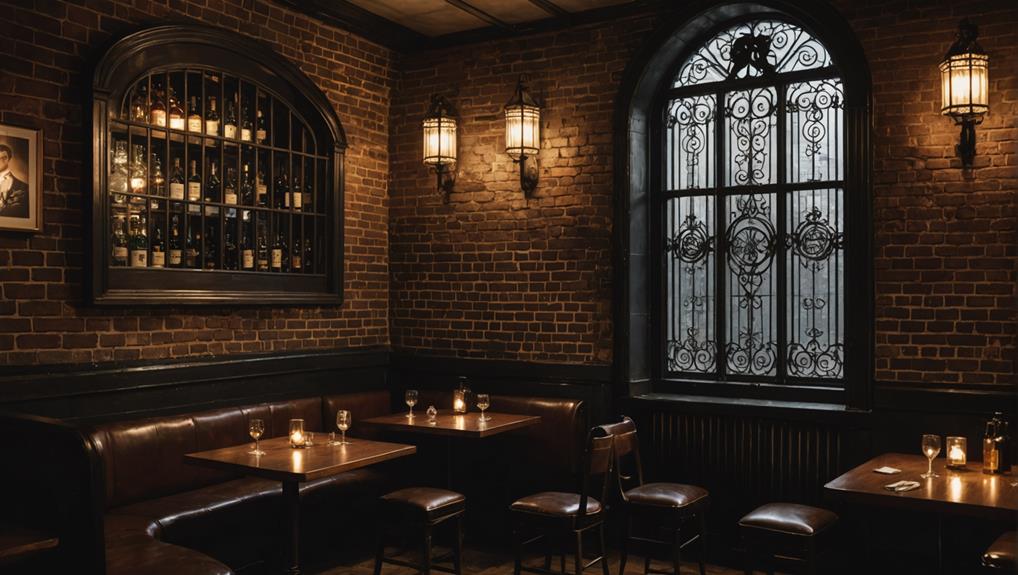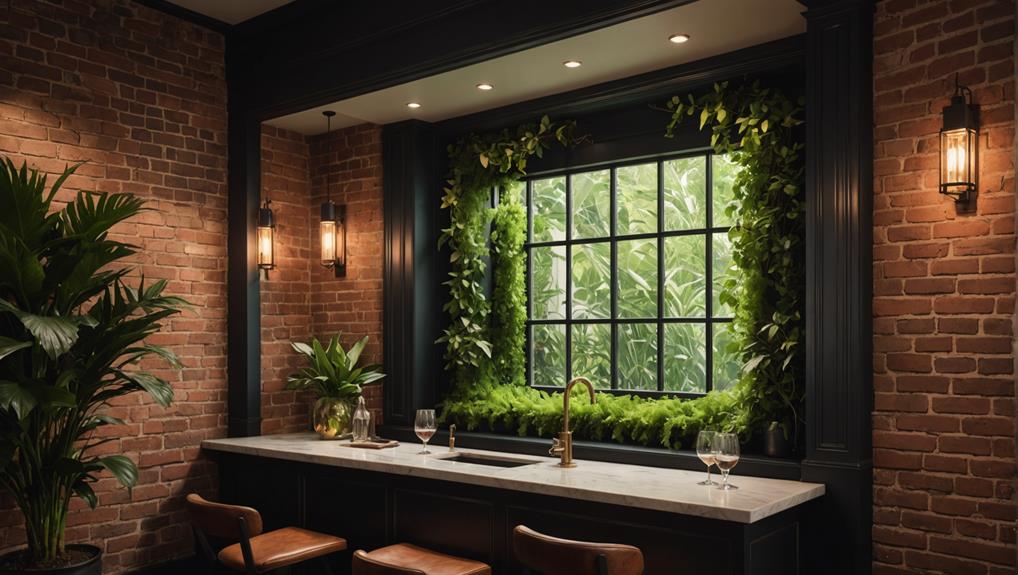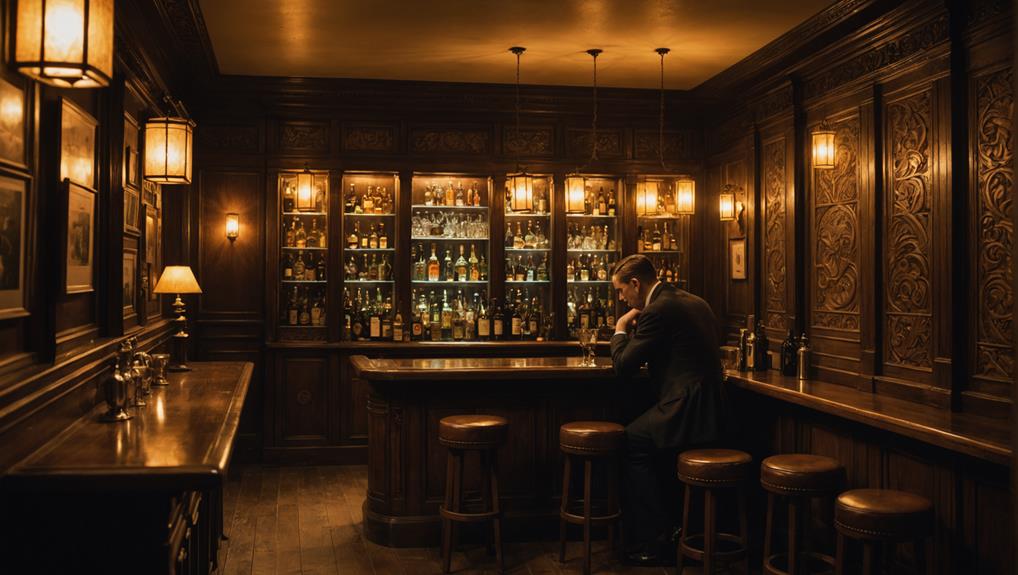Table of Contents
Speakeasy windows are designed with secrecy, functionality, and charm in mind, reflecting their origins during the Prohibition era. These windows feature discreet designs, hidden entrances, and small, barred openings that allow for safe access to illegal alcohol. You’ll notice ornate patterns that enhance their aesthetic appeal while adding to the air of mystery. The materials used, such as sturdy wood and tempered glass, ensure both durability and privacy.
Functionally, these windows are crafted for quick transactions, making it easy for all patrons to enjoy their experience. This thoughtful architecture represents a unique rebellion against restrictive laws. If you’re interested in how these designs influence modern venues, there’s plenty more to discover.
Historical Origins of Speakeasy Windows

Speakeasy windows emerged during Prohibition, allowing patrons to discreetly access illegal alcohol while avoiding detection. This period in U.S. history, from 1920 to 1933, led to significant changes in social dynamics. You’d find people enthusiastic to embrace the underground culture, gathering in hidden bars and secret venues. These windows became a vital architectural feature, creating a covert entry point for customers craving a drink.
As the prohibition history unfolded, the demand for alcohol didn’t simply vanish; it transformed. You’d notice a shift in how communities interacted, with individuals forming tighter bonds over shared defiance against the law. Speakeasy windows served as both a literal and symbolic barrier between respectability and rebellion, allowing those who dared to indulge in the forbidden to do so with a sense of adventure.
The clever design of these windows meant that patrons could slip in and out without attracting attention. You’d see how this reflected a broader trend of social resistance, where people sought to reclaim their freedom and enjoyment amid restrictions.
Fundamentally, speakeasy windows encapsulated a unique moment in American culture, blending secrecy with camaraderie during a time of repression.
Unique Design Features
When you think about speakeasy windows, you can’t help but notice their unique design features that reflect their historical context and purpose.
These architectural elements not only served as discreet entry points but also added a layer of intrigue and charm.
Let’s explore how these designs shaped the secretive nature of speakeasies and their lasting impact on architecture.
Historical Context and Purpose
During Prohibition, unique design features like hidden entrances and small, discreet windows helped create a sense of secrecy and exclusivity for patrons seeking a lively escape from the constraints of the law. These architectural choices were vital for the survival of speakeasy culture, allowing these illicit bars to operate under the radar while catering to a public keen to defy the restrictive societal norms of the time.
The small windows often served dual purposes: they provided a glimpse of the vibrant atmosphere inside while allowing for quick identification of potential law enforcement. This clever design played a significant role in maintaining the safety of patrons and the establishment.
The societal implications of speakeasy culture were profound, as these hidden venues fostered a sense of rebellion against Prohibition, promoting social interaction and a newfound freedom of expression.
This unique combination of architecture and purpose not only created a thrilling experience for guests but also contributed to the broader narrative of resistance during a tumultuous period in American history. Ultimately, these design features became symbols of a time when creativity and resilience flourished despite legal constraints.
Architectural Design Elements
Hidden entrances and cleverly placed windows define the unique architectural style of speakeasies, emphasizing a blend of secrecy and allure. These design aesthetics create an atmosphere that draws you in while keeping the establishment discreet. The windows serve more than just functional purposes; they embody architectural symbolism that reflects the era’s desire for privacy and rebellion against prohibition.
You’ll notice how the small, often barred windows are strategically positioned. They allow for a glance outside while ensuring patrons can remain hidden from prying eyes. This clever design encourages curiosity, inviting you to explore what lies beyond the entrance. The use of ornate patterns and intricate details in the window frames enhances the overall aesthetic, adding a touch of elegance that contrasts with the grim realities of the time.
As you enter, the ambient lighting and cozy layout further amplify the speakeasy’s charm. Each feature, from the muted colors to the vintage furnishings, contributes to the immersive experience. Fundamentally, these architectural design elements create a unique narrative that allows you to step back in time, embodying both the spirit of adventure and the need for discretion.
Materials Used in Construction

In constructing speakeasy windows, builders typically use a combination of sturdy wood, tempered glass, and durable metal accents to guarantee both security and style.
When selecting wood types, you might see options like oak, maple, or mahogany, each providing a unique aesthetic while ensuring long-lasting durability. Oak, for instance, offers a classic look that complements traditional designs, while maple can lend a modern touch due to its lighter color and smooth finish.
Glass choices are essential as well. Tempered glass is often preferred for its strength and safety features, making it ideal for these windows. This type of glass is resistant to breakage and shattering, which is particularly important in a speakeasy window designed for discreet access.
You might also encounter decorative glass options, like frosted or etched finishes, which can enhance privacy while still allowing light to flow through.
Security Considerations
When it comes to speakeasy windows, prioritizing security is vital to guarantee safe and discreet access. These windows often feature built-in security features that help protect both the property and its occupants. For instance, reinforced materials can deter break-ins, while secure locks ascertain that only authorized individuals can gain entry.
You’ll want to contemplate how access control plays a vital role in the overall design. A well-designed speakeasy window will often include a sliding or hinged mechanism that allows you to regulate who comes in and out. This design not only enhances security but also provides a level of privacy that standard windows can’t offer.
Additionally, modern advancements in technology can further bolster your security measures. For example, you might integrate smart locks or video monitoring systems that allow you to see who’s at the window before granting access. This way, you maintain control over who enters your space, minimizing risks while enjoying the charm of a speakeasy window.
Functionality and Accessibility

Functionality and accessibility are key aspects to evaluate, guaranteeing your speakeasy window not only looks great but also serves its intended purpose effectively.
When considering window accessibility, you should think about how easily you or your guests can interact with it. A well-designed speakeasy window allows for smooth operation, enabling quick transactions without hindrance.
You need to guarantee that the window operates efficiently, minimizing any potential delays during peak times. Operational efficiency is critical, especially in environments where service speed matters. If your speakeasy window is difficult to open or close, or if it obstructs the flow of guests, you may lose valuable business opportunities.
Additionally, consider the height and placement of your speakeasy window. It should be reachable for everyone, including those with mobility challenges. By prioritizing accessibility, you create an inclusive atmosphere that encourages more patrons to engage with your space.
Influence of Prohibition Era
During the Prohibition Era, hidden entry designs became essential for speakeasies, allowing patrons to access these secret spots without drawing attention.
You’ll see how these windows not only served a functional purpose but also became a powerful symbol of rebellion against restrictive laws.
It’s fascinating to contemplate how architecture can reflect societal attitudes and desires for freedom.
Hidden Entry Design
Hidden entry designs, born from the secrecy of the Prohibition era, cleverly concealed access points to speakeasies, making it easier for patrons to slip in unnoticed. These designs often featured concealed entrances, like hidden doors or disguised staircases, allowing guests to evade the watchful eyes of law enforcement. When you think about it, the ingenuity behind these secretive access points is both fascinating and practical.
Imagine standing outside a nondescript building, only to discover a cleverly camouflaged entrance tucked away in the shadows. These designs didn’t just serve a functional purpose; they also added an element of thrill and exclusivity to the experience. You’d feel like part of an underground world, where entry was a privilege reserved for the daring.
Additionally, architectural details like low-profile windows and discreetly placed signage contributed to the air of mystery, enhancing the allure of speakeasies.
When you step into a modern bar that pays homage to this era, you might notice how these hidden entry features continue to inspire contemporary design. It’s a nod to a time when secrecy was essential, and creativity flourished amidst restrictions.
Symbol of Rebellion
Speakeasies became a symbol of rebellion, challenging the restrictive norms imposed by Prohibition and offering a taste of freedom amidst the constraints of the era. These underground movements weren’t just about drinking illicitly; they represented a cultural shift, reflecting a desire for individuality and defiance. You could find people from all walks of life gathering in hidden spots, sharing a drink and a sense of camaraderie.
Here are some key aspects of their cultural significance:
- Social Unity: Speakeasies brought together diverse groups, fostering connections that crossed social boundaries.
- Cultural Expression: These venues often hosted jazz music, dance, and art, showcasing the creativity of the time.
- Political Statement: Frequenting a speakeasy was a quiet act of defiance against government control.
- Innovation: The need for secrecy led to inventive designs, like the infamous speakeasy windows.
Modern Adaptations and Trends

As modern bars and restaurants embrace the nostalgic charm of speakeasy windows, they’re reimagining these features to enhance ambiance and create unique guest experiences. You’ll find hidden bars that utilize these windows to engage patrons in urban nightlife, inviting them to peek inside and feel the thrill of exclusivity.
These adaptations often include larger, more decorative windows that capture attention while maintaining that air of secrecy. Some venues even use them as interactive elements, allowing guests to place orders or receive drinks directly through the window, adding a playful twist to the traditional concept.
You might notice that speakeasy windows now showcase a blend of old and new design elements, incorporating modern materials and lighting to create a vibrant atmosphere. This fusion not only pays homage to the past but also caters to contemporary tastes and social media trends, encouraging guests to snap photos and share their experiences online.


Leave a Reply